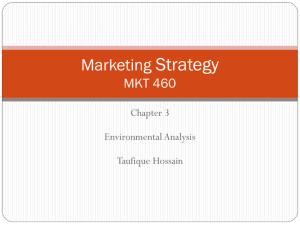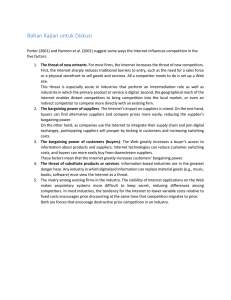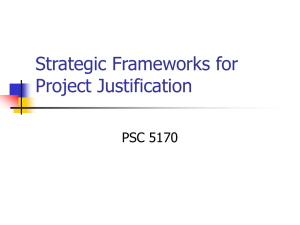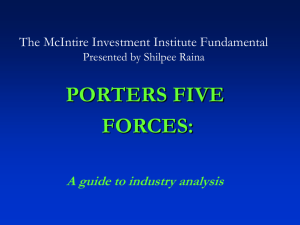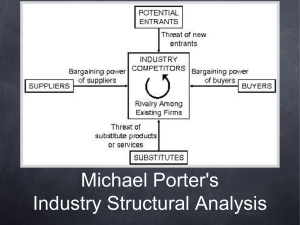Agenda
advertisement
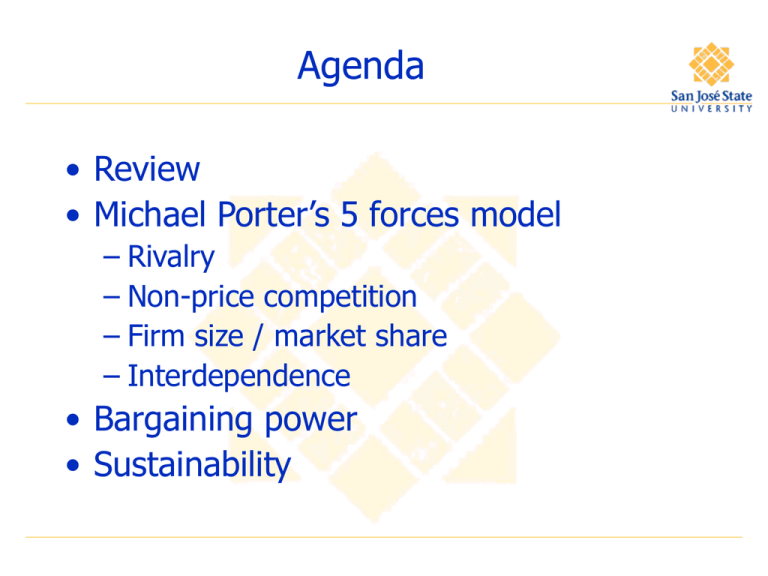
Agenda • Review • Michael Porter’s 5 forces model – Rivalry – Non-price competition – Firm size / market share – Interdependence • Bargaining power • Sustainability Porter’s Five forces model POTENTIAL ENTRANTS of new 3a. Threat entrants power 2a. Bargaining of suppliers INDUSTRY COMPETITORS SUPPLIERS power 2b. Bargaining of buyers BUYERS among 1. Rivalry existing firms of substitute new 3b. Threat products or services SUBSTITUTES Competitive Strategy, Porter, M.E., McMillan, 1980 Three stages in Porters external analysis 1. Analyze industry structure • How concentrated is it? • What are the dynamics 2. Analyze the industry's appropriability • Are there powerful buyers? • Are there powerful suppliers? 3. Analyze its long term viability • Will more firms enter? • Will substitute products or services be found? Industry competitors: Cournot’s model of competition Bargaining power of suppliers Suppliers Bargaining power of buyers Industry competitors Potential price LRAC 1 2 3 # of firms 4 5 6 Buyers Industry competitors: Concentration Suppliers Bargaining power of suppliers Bargaining power of buyers Industry competitors • How many firms (i.e. competitors) are there in our industry? Buyers 120 Firm sales ordered by size 100 80 • 4 Firm concentration ratio – Sum of revenues of four largest firms divided by total industry revenues – Sum of market shares of four largest firms (These are equivalent) 60 40 20 0 1 11 21 31 41 Industry Rivalry Suppliers Bargaining power of suppliers Industry competitors Bargaining power of buyers Buyers • Rivalry refers to the extent to which firms compete on the basis of price alone – Competing by out spending on advertising is not considered highly rivalrous – Competing by out spending on innovation is not considered highly rivalrous – Competing by cutting prices is considered highly rivalrous Industry Competitors: Summary Bargaining power of suppliers Suppliers Industry competitors Bargaining power of buyers Buyers • Is it a concentrated industry? • 4 firm concentration ratio (what % of total industry output is accounted for by the 4 largest firms) • concentrated if > 70% • fragmented if < 30% – If fragmented… • STOP HERE AND PROCEED INTERNAL ANALYSIS – Otherwise • Is there non-price competition? – e.g. around brand, through product innovation • • • • Are there large economies of scale ? Are there high barriers to exit? Is the product a commodity? Do companies segment the market and differentiate their products from each another? 2. Bargaining power Suppliers • Bargaining power of suppliers Bargaining power of buyers Industry competitors Suppliers (2a) – Are we buying from a monopoly (or from a highly concentrated industry)? (bad) – Does their product represent an insignificant portion of our product costs? (?) – Do we take a small (insignificant) proportion of their output (bad) – Can they forward integrate into our business? (bad) – Is it difficult for them to switch suppliers (good) • Buyers Buyers (2b) – Are we selling to a monopsony, (or into a highly concentrated market)? (bad) – Does our product represent a significant portion of the buyers product costs? (bad) – Do they take a significant proportion of our output (bad) – Can they backward integrate into our business? (bad) – Can they easily switch suppliers (bad) Porter’s Five forces model POTENTIAL ENTRANTS of new 3a. Threat entrants power 2a. Bargaining of suppliers INDUSTRY COMPETITORS SUPPLIERS power 2b. Bargaining of buyers BUYERS among 1. Rivalry existing firms of substitute new 3b. Threat products or services SUBSTITUTES Competitive Strategy, Porter, M.E., McMillan, 1980 3. Threat of new entry or substitution • Are there barriers to entry? (3a) – Economies of scale (good?) – Significant sunk costs (e.g. brand) to act as a deterrent – Does regulation restrict entry? (good) • How likely is it that a substitute product for the needs the industry currently meets will be found? (3b) • If no likely substitutes and entry barriers are high, above normal returns may persist over time. Entry Deterrence • Product proliferation – closing any open niches • Pricing – Limit pricing (scale) – Predatory pricing (illegal) – Price signaling • Excess capacity Porter 5 Forces Model – Summary • Grew out of industrial organization economics. – Concern with monopoly and oligopoly markets. – Focus was industry concentration. • Deals with the firm’s external environment. – Specifically its industry and the up- and down-stream industries. • Buyers are those that pay the focal firm for its services, not end users or consumers. • Sellers are those that sell goods and services to the focal firm, not the firm itself. • Large investments in ‘irrecoverable’ assets are a barrier to entry, requiring large amounts of capital per se is not.
